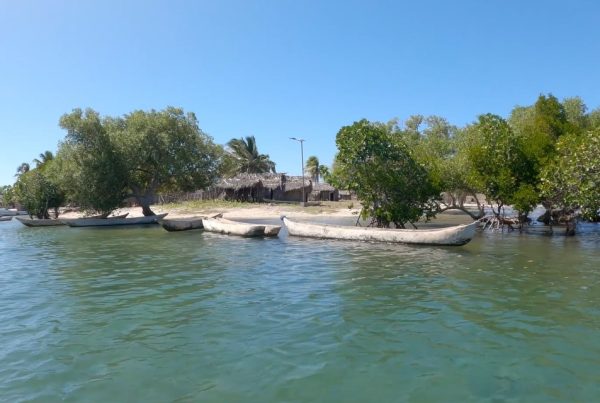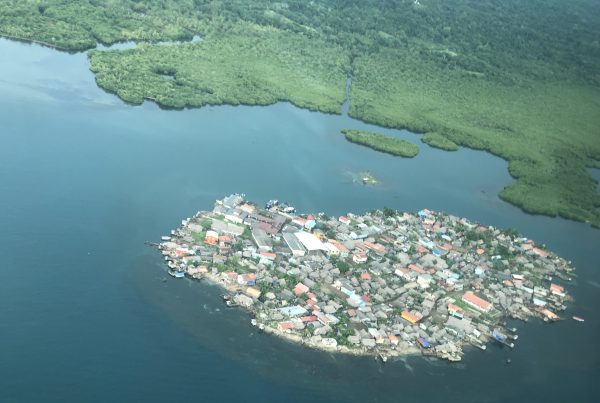We, indigenous Baiga Adivasis in central India, have lived by the forest, allowing its biodiversity to regenerate. Access to our customary sustainable use of biodiverse forest as our life-source is, however, threatened by forestry, mining, ecotourism and other commercial purposes which capture our jungles.
We are classified as a Particularly Vulnerable Tribe among India’s more than 100 million indigenous tribal people. Among vulnerable Adivasi communities, the percentage of malnourished children suffering from stunting and wasting belongs to the highest in the world as we become displaced from our sustainable, biodiverse sources of food, health, shelter and livelihood.
To save our biodiverse life-sources, our Bohil and Sarhapathra Baiga communities in Pandariya, in the Kabirdham district of Chhattisgarh State, developed biocultural community protocols (quoted below) on our customary sustainable use and conservation of biodiversity, our customary tenures and our traditional occupations.
Our village is situated on mountainous terrain. Our main livelihood source is gathering from forest and Bewar, our ancient shifting cultivation. From Jungle we bring many types of leaves of 42 edible species, also some flower leaves. Other leaves are found in marshy land. We have also technique of preserving them. Many leaves have high nutritional content and some also medicinal properties.
Baiga women collect leaves in the forest. Credit: ephotocorp.
Author
- Adiwasi Samta Manch
Ecosystems
- Tropical forests
Topics
- Food
- Knowledge, culture and spirituality
Type
- Short-form
Date
- This case study forms part of LBO-2, originally released in 2020.
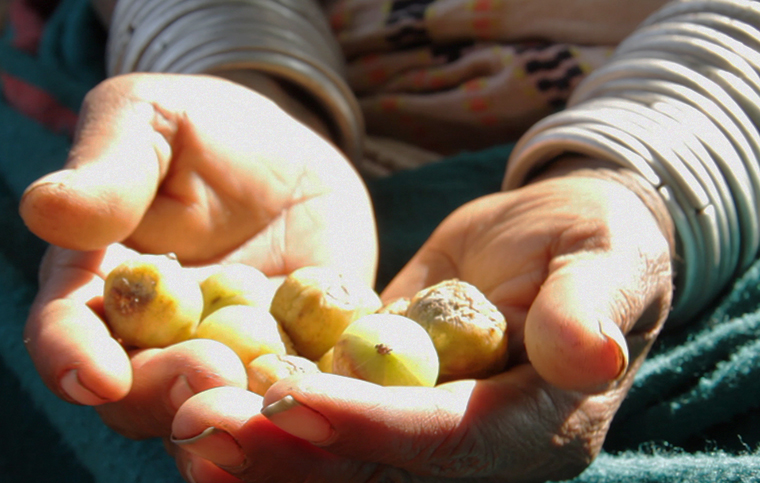
Amla fruit. Credit: Moushumi Basu
We know 93 medicinal plants we get from jungle to heal or prevent diverse health problems of stomach, breathing, digestion, malaria, fever, vein contractions, birth delivery pains, joint pains, snake bite, bone fractures and diseases of domestic animals. But many medicinal plants are now getting extinct. We are now in the process of reviving and restoring some of them. Jungle is our natural medicine house. Other people use the word ‘Baiga’ also as a generic term for indigenous healers.
Collection of minor forest produce from the forest is the mainstay of our livelihood. Our jungle gives us several fruits of 35 identified species and 17 mushroom species. Our land beneath forest provides us various types of tuber roots of 28 edible species, mostly wild. Also ropes, green utensils, brooms and necklaces are made from leaves. Soil, wood, grass and bamboo we gather to build houses, fences and straw-roofs. We use soil also to clean walls, wood for tools, and bamboo for baskets and handicrafts. Jungle’s 14 timber species are protected best in our hand.

A cultivator in Bohil. Credit: Ossi Kakko
In our land and forest we also do Bewar, or shifting cultivation, which makes our earth more biodiverse. Bewar produces 33 grain crops of millets, lentils, oilseeds, roots and other tasty and nutritious vegetables. Bewar recognises that earth is a living being and not an inanimate thing and ensures its maintenance of fertility. Earlier we used to do only Bewar, collecting forest produce and hunting. The entire village was surrounded by dense and deep forest when managed only by us. Now due to restrictions put by government, who has cut and displaced biodiverse forests, Bewar is suppressed and only hunting of few birds and catching fishes are allowed.
We can’t live without jungle, so earlier we used to go to places with dense forest and many times they were sloped and mountainous, so here to survive we used to do Bewar. We have learnt from our ancestors that, like us, land too needs rest. Leaving land fallow for at least three years in succession, Bewar gives rest to it. While cultivated area provides us millets, lentils, leaves, tuber-roots and vegetables to survive, in fallow there is growth of different varieties of wild roots, young minor forest produce-bearing trees and also a millet Sikia grows on its own in fallow.
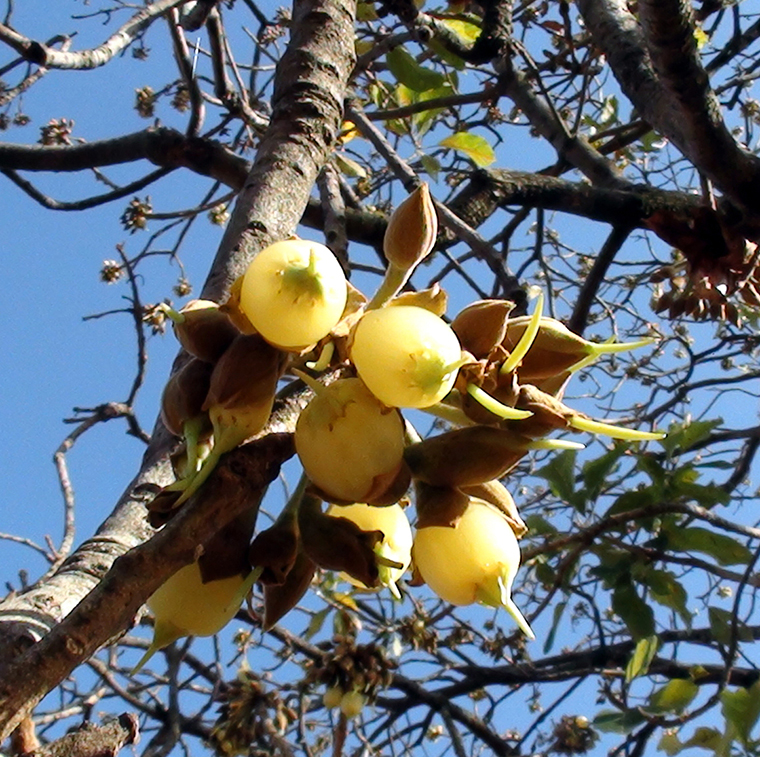
Mahua. Credit: Ossi Kakko
As our rights to sustain our biodiverse Bewar-based food plant varieties are threatened, it is all the more important to restore our Bewar. Earlier, we used to get more than enough from Bewar and we used to buy only salt and clothes. Today, we have to buy few more things which are neither tasty nor nutritious. What we get in market are unnatural things which make us prone to diseases. Bewar is much better and we do not fall sick after eating. Even though we don’t have money, we are happy and largely content. By exchanging what Baigas find from forest, they get many things from the market without currency, and many of the work we perform are carried out collectively, like making of huts or houses or roofing, without money wages.
Our existence is inextricably intertwined with jungle since eternity. We cannot imagine life without jungle and we derive our very identity from it. We have living relationship with its trees and plants above and below the Earth’s surface, animals, insects, birds, with mountain, river, air, land and all things which are as living as we. Also thorny plants and creepers in our jungle and shrubs which are of no direct use to us have their identity and right to exist like us. Their presence on Earth is as important as ours. Some animals give us signal of immediate future, too.
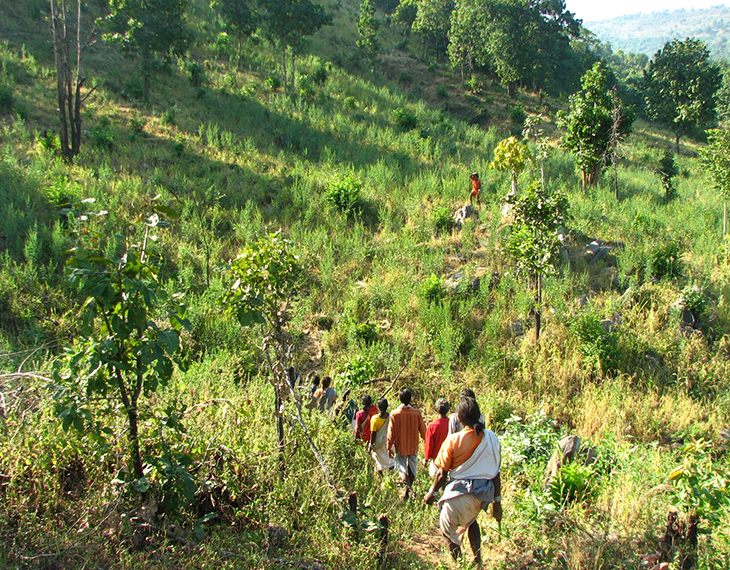
Shifting cultivation. Credit: Moushumi Basu
To save Earth’s diverse life, we dig out medicinal roots and herbs and take out seeds and fruits only after they ripen, and leave some so that they can again grow. We protect jungle from forest fire and forest ‘mafia’, and guard that we take only that much which can take care of our subsistence need, leaving enough also for birds and other living beings.
From our birth till death (and afterlife too), our land, jungle, with its biodiversity, plays all-pervasive role and defines our very identity and existence. We never consider ourselves as owner of forest but we think our identity and existence is linked with the forest.
We in Bohil and Sarhapathra are ‘Bhumiyas’, people who are Earth’s own, custodians of Earth’s life. Forest is our home where we live, work and spend most of our time. We can’t live without jungle but have a strong linkage to jungle with its biodiversities from our birth to death. Before woman gives birth, Maibell roots is given to her to chew, to increase the immunity and manage the pain. After giving birth she is fed with Bewar produce for five days.
We have lived by regenerating diversity of Earth’s life without displacing it. Our customary sustainable use and conservation of life’s diversity is maintained by our customary tenure and traditional occupations. But we fear that people from outside will come and take our natural resources and may even evict us.
As some others do not like our Bewar, so first of all we need end of fear in carrying out Bewar. Government should re-recognise our Bewar to be secured as it is good for conservation of biodiversity of crops and wild plants, making also diverse ages of young fallows to grow side by side when duly allowed to shift and rotate. It sustains biodiverse cultivations as free of chemical fertilisers and pesticides which lead to several types of diseases and tasteless food.
Having now very little land left and not much scope left to rotate, we can leave fallow only one patch and return to it after every 3–4 years. Earlier we used to shift from one village to another but now it is not possible. Without adequate land for Bewar, we must supplement our food production by ploughed fields and less biodiverse cultivations.
Government should help us making our forest more biodiverse and minor forest produce-rich, compliant to our forest management plans; recognise our traditional livelihood practices, skills and traditional knowledges as our collective property; and respect our Bio-Cultural Community Protocol compliant to its international commitments.
“What people need for living in harmony with Earth and to save its life’s diversity, are rights to live by regenerating.”1
This presentation of Baiga communities’ contribution to the sustainable use and conservation of biodiversity addresses particularly the issues of Aichi Target 18 on how customary sustainable use and conservation of biodiversity can be advanced by customary tenures and traditional occupations like gathering, shifting cultivation, and handicrafts. But it also addresses the contribution of Baigas on their living experiences of protecting, governing and managing their lands and forests as relevant to Aichi Targets 1, 5, 7, 8, 11–16 and to SDGs 1, 2, 3, 5, 10, 11, 12 and 15.
References
- See the Bohil and Sarhapathra biocultural community protocols: Adivasi, (n.d.) ‘Biocultural documents.’ Available at: http://adivasi-info.net/Biocultural_Documents.html


